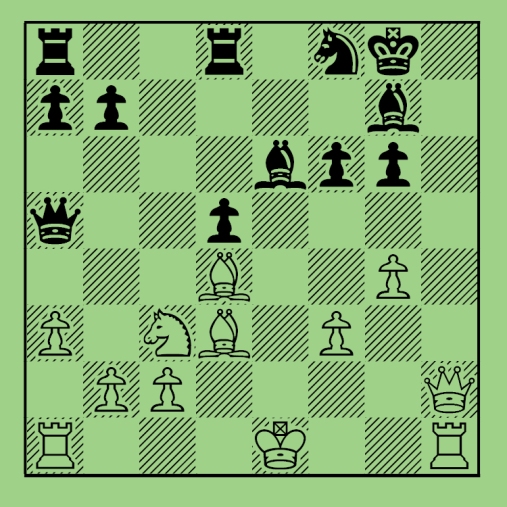During his playing career Botvinnik battled played a number of players who were of GM strength in secret matches. They were all played in the USSR, and were meant to prepare him for Olympiads, important tournaments, and matches with Western (i.e., non-Warsaw Pact) players.
They were played in secret so Botvinnik could experiment with different openings, and of course to keep any loses away from prying Western eyes.
His most common match player during the 1950s was GM Averbakh.
As he put it, “As a sparring partner, I evidently suited Botvinnik, and over the next two years we played about 25 training games. The time control was the standard one of two and a half hours for 40 moves. If a game remained unfinished, it was not normally resumed.”
Here are four of those secret games.
~~~~~~~~~~~~~~~~~~~~~~~
GM Botvinnik-GM Averbakh
Training Game
Moscow, Oct. 1955
[By the mid-1950s, Averbakh was considered an expert in the endgame. But here, he never gets to the endgame!]
1.e4 c5 2.Nf3 d6 3.d4 cxd4 4.Nxd4 Nf6 5.Nc3 g6 6.Be3 Bg7 7.f3 Nc6 8.Qd2 O-O 9.g4 Nxd4 10.Bxd4 Qa5 11.h4 Be6 12.h5 Rfd8 13.hxg6 hxg6 14.a3 d5 15.e5 Nd7 16.Qh2 Nf8 17.Bd3 f6 18.exf6 exf6 (White has the advantage and can win a number of ways. He chooses the most direct route.)

19.b4! (Trapping the queen.) 1-0
GM Botvinnik-GM Averbakh
Training Game, June 6 1955
[E56]
[With everything else being equal, a passed pawn is worth more than a pawn.]
1.d4 Nf6 2.c4 e6 3.Nc3 Bb4 4.e3 O-O 5.Bd3 d5 6.Nf3 c5 7.O-O Nc6 8.a3 (8.Qc2 is also good.) 8…Ba5 9.cxd5 exd5 10.dxc5 Bxc3 11.bxc3 Bg4 12.c4 Ne5 13.cxd5 Nxf3+ 14.gxf3 Bh3 15.e4! (White is willing to give up the exchange for a powerful, mobile pawn center.) 15…Nd7
[So why can’t Black take advantage of the exchange sacrifice?
Here is one answer:
Jesus Rodriguez-Oscar Vieira Ferreira (2065)
Argentina Team Tournament
Tucuman, 1971
15.e4 Bxf1 16.Bxf1 Nd7 17.Be3 f5 18.Bh3 fxe4 19.fxe4 Ne5 20.f4 Nc4 21.Qd4 Nxe3 22.Qxe3 Qf6 23.Rf1 Rae8 24.e5 g5 25.Qg3 Qg7 26.Be6+ Rxe6 27.dxe6 gxf4 28.Qxg7+ Kxg7 29.Rd1 Rf5 30.Rd7+ Kg6 31.Rd5 Kg7 32.e7 Kf7 33.e6+ Kxe6 34.Rxf5 1-0.
The text game provides another answer.]
16.Kh1 Bxf1 17.Bxf1 Nxc5 18.Be3 b6 19.e5 Qd7 20.f4 Rfd8 21.Bg2 Rac8 22.Qf3 Nb3 23.Rd1 Rc3 24.f5 Nc5 25.f6 Rd3 26.Rg1 g6 27.Qf4 Qe8 28.Bxc5 bxc5 29.Re1 R3xd5 30.Bxd5 Rxd5 31.Qh6 Qf8 32.Qh3 Qd8

33.e6! 1-0
GM Botvinnik-GM Averbakh
Training Game, Oct. 1956
[E29]
1.d4 Nf6 2.c4 e6 3.Nc3 Bb4 4.e3 O-O 5.Bd3 c5 6.a3 Bxc3+ 7.bxc3 Nc6 8.e4 cxd4 9.cxd4 Nxd4 10.e5 Qa5+ 11.Kf1 Ne8 12.Bb2!? [White has two good choices here; 12.Bd2 (ECO’s line), and 12.Bb2, which seems to be a Botvinnik TN.] 12…Nc6 13.Nf3 f5 14.Qc2 d6 15.Re1 dxe5 16.Nxe5 Nf6 17.h3 Qc5 18.g4 Ne4 19.Nxc6 Qxc6

20.Rg1! (White’s next moves are designed to open the diagonals for his bishops by eliminating the center pawns.) 20…Rf7 21.Re3 Qc5?! (21….Kf8 might seem anti-thematic, and perhaps even a little bizarre, but it’s important to get out of the soon-to-opened g-file.) 22.gxf5 exf5 23.Bxe4 fxe4 24.Qc3 1-0
GM Botvinnik-GM Yuri Averbakh
Training Game, 1956
[C63]
1.e4 e5 2.Nf3 Nc6 3.Bb5 f5 4.Nc3 fxe4 5.Nxe4 Be7 6.Bxc6 dxc6 7.d3 Nf6 8.Qe2 [Botvinnik has what he wants; a few small advantages (in this case, space and positional) he can take to the endgame.] 8…Bg4 9.h3 Bxf3 10.Qxf3 Qd5 11.Bg5
[Also good is 11.O-O O-O 12.Be3 Rad8 13.b3 b6 14.Rad1 Qd7 15.Nxf6+ Rxf6 16.Qg4 Qd5 17.Qe4 Rg6 18.Kh1 Re8 19.f3 Rf8 20.Bg1 Bd6 21.Rde1 Re8 22.Re2 Rg5 23.Bh2 Rh5 24.Rfe1 Qa5 25.Qxc6 1-0, E. Szalanczy (2237)-M. Lyell (2225), First Saturday, Budapest, Sept. 4 2012.]
11…Nxe4 12.dxe4 Qf7 13.Qxf7+ Kxf7 14.Be3 Ke6 (Black’s king travels to the center to contest the center squares.) 15.Ke2

(White’s advantages are now easier to perceive. One is that two of Black’s queenside pawns are doubled. A bigger problem is that his e5-pawn is isolated. Finally, White’s bishop has more freedom of movement than Black’s. Black’s biggest plus is his strongly placed king on e6.)
15…Rhf8
[Black can also try 15…Rad8. After 16.Rad1 (not 16.Bxa7? b6!) 16…Rd6 17.Rxd6+ cxd6 18.a4 (Again, not 18.Bxa7? due to 18… a8). Stockfish prefers 15…Rad8 16.h4 h5 17.g3 Rd7 18.a4 g6 19.Rag1 a6 20.Ra1 Rhd8 21.f3 Rf8 22.Rhg1 Rdd8 23.Rgb1 Rf7 or even the more immediate 15….h5 16.h4 a6 17.g3 Rad8 18.a4 a5 19.Rag1 g6 20.Rc1 Rhf8 21.Ra1 Rh8 22.Rag1 b6 23.f3 Rhf8. Verdict: White has definite, and annoying (for Black), advantages. The big question is: “Can White win?” The answer is: “Probably yes, especially if you are a GM”.]
16.h4 Rf7 17.h5 h6 18.Rh3 Bg5 19.Rd1 Raf8 20.f3 a5 21.Rg3 Kf6 22.Rg4 a4 23.g3 Ke6 24.Rf1 Bxe3 25.Kxe3 Rd7 26.f4 Rf6 27.Rg6 Kf7 28.fxe5 Rxf1 29.e6+ Ke7 30.exd7 1-0
[30….Kxd7 31.Rxg7+ Kd6 (31…Kd8 is passive. White will eventually win by slowly, surely, and simply moving up the board. Black’s only chance to bring his king up and challenge White for control of the board. But White still wins.) 32.Rg6+ Ke5 33.Rxh6 Rc1 34.Rh8.]
